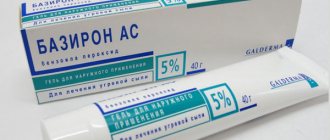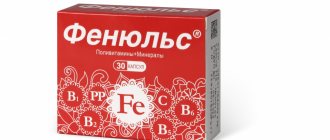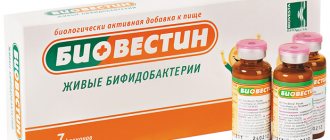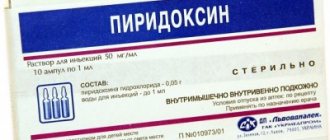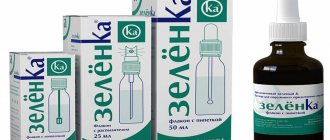In the article we will look at the density of hydrogen peroxide, as well as in what areas of life it is used.
Almost every home always has hydrogen peroxide. And if there is none, it can be purchased at absolutely any pharmacy. This is one of the most inexpensive, but at the same time useful means, which has a large number of advantages.
What is the density of hydrogen peroxide depending on the concentration? We'll talk about this below.
This product is a colorless liquid with powerful oxidizing properties, which allows it to act as a bleach. In addition, these same properties can react with bacteria, spores, viruses, and fungi, making it act as a good disinfectant. Interestingly, in high concentrations it can serve as a fuel in rocket science.
Density of hydrogen peroxide
Pure peroxide is a viscous, colorless liquid.
The density of hydrogen peroxide is 1440 kg/m. Moreover, its melting and boiling points are 0.45 and 151.3 degrees, respectively. Unlike water, such peroxide is an unstable compound. It can decompose even when exposed to room temperature and very easily when exposed to light or contact with certain catalysts. In a dilute aqueous solution, hydrogen peroxide is much more stable.
The hydrogen peroxide solution density table is presented below.
The slight stability of molecules of the formula H2O2 is due to the fragility of the bond. Peroxide can be mixed with water in absolutely any ratio. It is stored in dark glass containers.
Obtaining H2O2.
H2O2 molecules are always produced in small quantities during the combustion and oxidation of various compounds. During combustion, H2O2 is formed either by the abstraction of hydrogen atoms from the starting compounds by intermediate hydroperoxide radicals, for example: HO2 . + CH4 ® H2O2 + CH3 . , or as a result of recombination of active free radicals: 2OH . ® H2O2, N . + HO2 . ® H2O2. For example, if an oxygen-hydrogen flame is directed at a piece of ice, then the melted water will contain noticeable quantities of H2O2 formed as a result of the recombination of free radicals (H2O2 molecules immediately disintegrate in the flame). A similar result is obtained when other gases burn. The formation of H2O2 can also occur at low temperatures as a result of various redox processes.
In industry, hydrogen peroxide has long been no longer produced using the Tenara method - from barium peroxide, but more modern methods are used. One of them is electrolysis of sulfuric acid solutions. In this case, at the anode, sulfate ions are oxidized to persulfate ions: 2SO42– – 2e ® S2O82–. The persulfuric acid is then hydrolyzed:
H2S2O8 + 2H2O ® H2O2 + 2H2SO4.
At the cathode, as usual, hydrogen evolution occurs, so the overall reaction is described by the equation 2H2O ® H2O2 + H2. But the main modern method (over 80% of world production) is the oxidation of some organic compounds, for example, ethylanthrahydroquinone, with atmospheric oxygen in an organic solvent, while H2O2 and the corresponding anthraquinone are formed from anthrahydroquinone, which are then reduced again with hydrogen on a catalyst into anthrahydroquinone. Hydrogen peroxide is removed from the mixture with water and concentrated by distillation. A similar reaction occurs when isopropyl alcohol is used (it occurs with the intermediate formation of hydroperoxide): (CH3)2CHOH + O2 ® (CH3)2C(OOH)OH ® (CH3)2CO + H2O2. If necessary, the resulting acetone can also be reduced to isopropyl alcohol.
Substance formula
The empirical formula for hydrogen peroxide is as follows: H2O2. The chemical composition of the drug is represented by hydrogen and oxygen, with each element having two atoms.
This unique liquid in the world is known primarily for its medicinal properties. Next, we will consider in detail the methods of using hydrogen peroxide.
How to check for suitability?
Regardless of whether the bottle of hydrogen peroxide is opened or not, the process of its breakdown into water and oxygen always occurs: 2 H 2 O 2 → 2 H 2 O + O 2 (g).
Even in a closed container, gas formation occurs, but the reaction proceeds much more slowly than when the substance comes into contact with a cut or other surface.
The gas formation reaction, that is, the appearance of bubbles, is facilitated by transition metals , for example, the presence of iron in the blood.
If you are not completely sure about the suitability of H2O2, there is a safe way to check it. Simply spray a little peroxide into the sink or onto a potato cut.
If the solution “hisses,” it means the product is suitable for further use. There are no bubbles - it's time to replace the bottle.
You should not open the container with the substance in advance and pour H2O2 into another container, especially one made of transparent glass.
For bad breath
If the unpleasant odor does not go away from the mouth even after a person brushes his teeth, then hydrogen peroxide can be used as a mouthwash. This procedure should continue for thirty seconds and the person will be surprised by the result. But, again, you cannot overdo it; you should use peroxide for these purposes only once a week, since the substance also kills beneficial bacteria in a person’s mouth.
GOST requirements
Almost all of us have low concentrations of H2O2 at home. It is used for disinfection, cleaning or cosmetic procedures. For medical purposes and industrial production, perhydrol is used in a concentration of 30 to 40%.
- 3 and 5 percent concentrations are suitable for use for 12-36 months, provided that the container in which the product is stored is closed. If its integrity has been compromised, then the drug will be effective for a month and a half. Based on the requirements of GOST, this concentration of hydrogen peroxide has a shelf life (if the package is closed) - 2 years, after opening - 30 days. If a solution was prepared using the substance in question, then its shelf life should not exceed one day of light.
- High concentrations (30%-40%) have strong oxidizing properties and can be very dangerous if perhydrol is not stored correctly or safety precautions are violated. Based on the requirements of GOST, the shelf life of such a concentration should not exceed 6 months from the date of production. If any solution has been prepared, its shelf life is 1 day.
For ear infection
Peroxide drops can be used to clear infections or clogged ears. However, it is worth remembering that a person will still have to see a doctor, since not all ear infections can be cured on their own, and they can lead to serious complications.
Hydrogen peroxide can also help with ear congestion.
Can the product be used if the period has expired?
The answer to this question is simple: you can use the drug, but it is not necessary, due to the fact that after the expiration date or storage conditions are violated, it loses all its medicinal properties.
Any medicines are primarily chemically synthesized compounds, often toxic. Read articles from our experts on how to store and what is the permissible shelf life of Phenazepam, Paracetamol, Otipax, Levomekol, Acyclovir, iodine, potassium permanganate, Linex, as well as what to do with expired medications in everyday life and how to dispose of expired medications.
Is it dangerous to use an expired drug?
The whole danger to a person when using an expired medication, which is discussed in the article, lies in the pointlessness of its use. In other words, there will be no harm, as well as benefit.
We talked about the cases in which medications can be used after the expiration date in this article.
What are the signs of a spoiled substance?
In order to check the suitability of this drug, you need to spray the solution on a cut of potato. If the solution fizzes, it means it can be used. If this does not happen, then the peroxide is spoiled and should not be used.
As for the disposal of a small amount of peroxide at home, after diluting it with water it will not cause any harm to the environment, although this contradicts the most strict interpretation of the rules for the disposal of hazardous waste.
If you find an error, please select a piece of text and press Ctrl+Enter.
Foot fungus
If a person suffers from itchy feet, hydrogen peroxide can be a very useful remedy due to its antifungal properties. Take equal parts of this product and water, and then spray it on your feet as a spray. Leave until dry, and then you can rinse your feet. This is a good preventive method against such a disease.
Mechanism of action
The mechanism of action of this product is the interaction of human tissues with the release of molecular oxygen; the tissues contain the enzyme catalase, which breaks down the composition, and oxygen participates in the oxidation process, accompanying it with pronounced foaming. This foam mechanically cleans the damaged surface, removes pus, germs, dead cells, and stops bleeding.
It is important to respect the expiration date of hydrogen peroxide.
Lightening hair with hydrogen peroxide
If the roots of bleached hair begin to show, you should blot them with peroxide and leave for half an hour, and then rinse. Hydrogen peroxide can also be used to achieve gradual discoloration. Mix equal parts of the product and water, then add to the spray bottle. Then spray the solution onto the hair, distributing the product with a comb. Next, you need to wait until it is completely dry. It is worth considering that if you often resort to this method, bleached strands will appear on your hair.
Can hydrogen peroxide be used internally? What does it help with in this case?
Optimal conditions
Conditions:
Dark room. Avoid direct sunlight on the bottle.- Darkened container. It should not allow light to pass through.
- Temperature conditions.
The maximum permissible is up to plus 30 degrees Celsius. But the properties of the substance are better preserved at a temperature no higher than 18 degrees. - Humidity. It should not exceed 40%. The lower this indicator, the longer the solution will be stored.
Ingestion
It is worth noting that this is a fairly strong antiseptic, which is used as a hemostatic agent. As a rule, it is used only externally. But is it permissible to drink hydrogen peroxide, and what should you do when it enters the body? If used correctly, this drug is completely safe, and it can even have a positive effect on the stomach, as it increases the amount of mucus that protects against the action of various acids.
But if you take hydrogen peroxide internally in its pure form, this can lead to internal bleeding, nausea, and, in addition, burns of the digestive system. Pain in the throat and stomach is possible. In addition, there is a risk of intoxication along with blockage of blood vessels in the kidneys and heart.
Areas of use
Hydrogen peroxide can be of different concentrations. Since solutions have different properties, they are often used in industry and everyday life:
- The substance is used in the creation of paper, disinfectants and in textile production as a bleach.
- Hydrogen peroxide is used as rocket fuel for its oxidizing properties.
- In analytical chemistry in the manufacture of porous materials, the product is used as a foaming agent.
- In industry, the simplest representative of peroxides has proven itself as a catalyst and hydrogenating agent.
- In aquarium farming, a 3% solution helps clean water tanks, fight parasites, and can also revive suffocated fish.
- In the food industry, peroxide is used to disinfect packaging for various beverages and surfaces of equipment with which food comes into contact.
- In the household sphere, the product helps remove potassium permanganate stains on furniture and textiles, and also as a home antiseptic.
Peroxide is widely used in the field of cosmetology. It bleaches hair and whitens teeth. Since the process is based on oxidation, curls often deteriorate, so the substance is not recommended for use by owners of thin and damaged strands. There are no defects in the teeth, since with transparent enamel the whitening effect is achieved due to the difference in the reflection of light by the dentin.
Taking peroxide orally according to Neumyvakin
Thanks to the work and experiments of the scientist Neumyvakin, oral hydrogen peroxide therapy has become understandable and accessible. A famous doctor, while researching hydroperite, conducted tests on himself and determined all the properties of this drug. The remedy in question, according to his statement, can fight cancer, it removes accumulated fats from the walls of blood vessels, and treats leukemia. You should use this drug every day, while the internal tissue will be saturated with oxygen. In addition, the drug is used in the following situations:
- Against the background of joint diseases.
- In order to prevent the development of atherosclerosis.
- In case of psoriasis.
- As part of the fight against fungal infections and viruses.
- To improve the functioning of the immune system.
- In case of hypertension.
- To combat influenza and otolaryngological diseases.
- Preventing tumor growth.
- To cope with diseases of the throat, ears and nose. To do this, fifteen drops of peroxide must be instilled into the painful area.
- Against the background of depression.
- In order to alleviate gum disease (to do this, twenty drops of hydroperite must be mixed with half a spoon of soda and two drops of lemon juice, then mix everything and brush your teeth).
- In case of presence of varicose veins.
According to the recommendations of the scientist Neumyvakin, peroxide should be taken orally three times, one drop of a three percent solution. The product must be dissolved in a quarter glass of water. Then you need to add a drop every day, bringing the single dosage to ten. Then they take a short break (three or four days); after resting, the solution with peroxide must again be taken ten drops throughout the week. Then a break is taken and everything is repeated again.
Removal of wax plug (ear lavage) – City Med Clinic Orenburg
Earwax is a substance produced by modified sebaceous glands located in the skin of the external auditory canal.
Its role is to protect the ear canal from dust, water, small particles, microorganisms (viruses, bacteria, fungi) that can penetrate the ear with water or air. There should always be a small amount of sulfur in the ear canal - this is a natural protection of the internal structures of the ear from external aggressive and pathogenic agents. Sulfur plug in Latin is called cerumen. The name "cerumen" is derived from the term "ceruminous glands", which in Latin means "glands that produce sulfur." Any cerumen plug is an accumulation of sulfur and dead cells of the desquamated epidermis (lining the ear canal), which can be mixed with fungal casts and pus. The wax plug is always located in the external auditory canal of one or both ears and, accordingly, clogs it completely or partially, which gives the name to this formation. Types, prevalence and general characteristics of wax plugs in the ear Wax plugs are essentially a lump of earwax mixed with desquamated epidermal cells. All components in the ear canal stick tightly together, forming a lump. This lump partially or completely covers the external auditory canal, depending on its size and location. The consistency of wax can vary, ranging from soft and runny, similar to honey, to dense and hard, like stone. Depending on the consistency of the wax plug, the following types are distinguished:
- Paste-like sulfur plugs are colored light yellow or dark yellow and have a soft, moderately fluid consistency, reminiscent of fresh honey;
- Plasticine-like sulfur plugs are colored in various shades (from the lightest to the darkest) of brown and have a viscous but pliable consistency that can be given any shape;
- Solid sulfur plugs are dark brown or black in color and have a hard and dense consistency. To the touch, such sulfur plugs are dry and look like stones or pieces of earth.
Moreover, any sulfur plug in the process of its development goes through all of the above stages in turn, first being paste-like, then becoming plasticine-like, and finally turning into solid. Initially, any cork has a paste-like consistency. Subsequently, the consistency of the plug depends on how long it remains in the ear canal. The more time the plug was in the ear canal, the denser its consistency. Accordingly, hard wax plugs are lumps of wax that have been “lying” in the ear for a long time, while paste-like ones have formed quite recently. Depending on the location and volume, the cerumen plug can be parietal or obturating. The parietal wax plug is attached to any one wall of the ear canal and only partially covers its lumen. The obturating cerumen plug completely closes the lumen of the ear canal. In addition, there is a special type of sulfur plug, which is called epidermal, because it is formed from crumpled cells of desquamated epithelium. This plug is hard as a stone, painted white or light gray and is very tightly attached to the walls of the ear canal. Due to its tight attachment to the walls of the ear canal, the epidermal plug is difficult to separate and can provoke the formation of bedsores in the narrow bony part in front of the eardrum. Ear plugs occur with equal frequency in people of both sexes of any age. This means that wax plugs are equally common in children and adults, as well as in women and men.
Additional uses
Hydrogen peroxide is used, among other things, as follows:
- Like a deodorant. It can also be used as a deodorant, mixed in a ratio of one to two with dishwashing detergent. Apply this mixture for thirty minutes and wash off. This product can be used as a last resort if a person forgets to buy deodorant.
- Like a detox bath. This procedure helps rid the body of toxins; it has antibacterial and antiviral properties. Fill the bathtub with warm or hot water, adding two cups of hydrogen peroxide. Take a bath for thirty minutes.
- For cleaning contact lenses. This eye tool accumulates protein deposits. One option to get rid of them is hydrogen peroxide, which is an active ingredient in many cleansing preparations.
- For disinfecting toothbrushes. You should apply a little hydrogen peroxide to your toothbrushes from time to time. This will help destroy bacteria and also reduce the likelihood of them entering the body.
- Softening calluses. If calluses and corns appear on a person’s feet, a mixture of peroxide and water will help soften them.
Chemical features
Since both oxygen atoms are in the intermediate oxidation state -1, the antiseptic can exhibit both oxidizing and reducing properties. It participates in the oxidation of nitrites to nitrates and the release of iodines from metal iodides. The substance can also break down unsaturated compounds.
Peroxide has weak acidic properties, so it dissociates in two steps:
- H2O2↔H++OOH−
- OOH−↔H++O22−
The substance is slightly more acidic than H2O. Some metal peroxides can be considered as its salts. In an acidic environment, peroxide serves as an oxidizing agent, and in an alkaline environment, it serves as a reducing agent.
Reacting with stronger oxidizing agents, for example, with salts of silver and gold, hydrogen serves as a reducing agent and is oxidized to atomic oxygen. In the reaction with potassium nitrite, the substance acts as an oxidizing agent. If the molecule accepts an electron to the outer level, then the oxidation state of oxygen changes to -2; if she gives it away, then the compound becomes a reducing agent. Oxidation of organic substances with peroxide is usually carried out in acetic acid.
Biological properties
Hydrogen peroxide is a reactive form of oxygen and, when produced in excess in the cell, causes oxidative stress. Some enzymes, such as glucose oxidase, produce hydrogen peroxide during the redox reaction, which can play a protective role as a bactericidal agent. Mammalian cells do not have enzymes that reduce oxygen to hydrogen peroxide. However, several enzyme systems (xanthine oxidase, NADP•H oxidase, cyclooxygenase, etc.) produce superoxide, which is converted spontaneously or under the action of superoxide dismutase to hydrogen peroxide.

